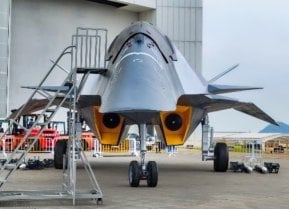The Navy's Zumwalt-Class Stealth Destroy Has Its 'Ride or Die' Moment
The CPS installation will represent a leap forward in offensive capabilities for the Zumwalt—but is unlikely to redeem the beleaguered class sufficiently to justify the platform’s expense.
The USS Zumwalt is currently undergoing a two-year modernization process to install the Conventional Prompt Strike (CPS) hypersonic missile system. The CPS installation will represent a leap forward in offensive capabilities for the Zumwalt—but is unlikely to redeem the beleaguered class sufficiently to justify the platform’s expense.
What is the Conventional Prompt Strike system?
According to the CPS’s developer, Lockheed Martin, the CPS “is a hypersonic boost-glide missile development and test program that provides longer range, shorter flight times, and high survivability against enemy defenses.” That’s corporate speak for a weapon that flies exceptionally fast. Capable of exceeding Mach 5 speeds (or one mile-per-second), hypersonic weapons could offer the ability to deliver precision-guided conventional weapons on-target anywhere in the world, within just one hour. In theory, such capabilities offer swift responses, akin to an intercontinental ballistic missile, with more flexible deployment options, i.e., a Zumwalt-class destroyer.
The Zumwalt is expected to be fully outfitted with the CPS sometime in 2025. The Navy awarded Huntington Ingalls Industries (HII) $154.8 million to modernize the Zumwalt with the CPS system. “The contract, scheduled to be completed by September 2025, will replace the original twin 155mm Advanced Gun Systems on the destroyer with four 87-inch missile tubes,” USNI reported last year.
The CPS system’s four 87-inch tubes will each hold three Common Hypersonic Glide Bodies (C-HGB) hypersonic missiles, which are “part of the Pentagon’s conventional strategic weapon systems that can strike any target on the planet with minimal warning.”
The C-HGB rollout may be delayed, however—which in turn would delay the maintenance period for the Zumwalt, according to the Government Accountability Office (GAO). “If the hypersonic weapon is not ready for integration on the DDG 1000 at the time of the aforementioned maintenance period, the Navy may have to extend the duration of the planned maintenance period or wait for the next scheduled period to incorporate the system on the ship,” the GAO reported.
Regardless of the CPS installation, or the timing of the C-HGB rollout, the Zumwalt is unlikely to be fully redeemed as a class.
Redeeming the Zumwalt
The Zumwalt was once heralded as the future of the U.S. Navy, with plans for a thirty-two-ship fleet. But budget overruns and performance problems caused the Navy to abandon the project after procuring just three ships, and instead rely on the destroyer the Zumwalt was supposed to replace, the Arleigh Burke.
Before the project was cancelled, the Navy invested $24 billion into the Zumwalt. Making such a heavy investment worthwhile depends upon mass-producing the product. With just three Zumwalts produced, that means each ship cost $8 billion dollars. That’s an expensive destroyer (bear in mind that Nimitz-class aircraft carriers cost about $7 billion or $8 billion). Had production for the Zumwalt continued as planned, costs per vessel would have dipped significantly. But with the plug pulled, the price per vessel will remain egregious.
The installation of the CPS is unlikely to make the Zumwalt’s value proposition worthwhile.
About the Author:
Harrison Kass is a defense and national security writer with over 1,000 total pieces on issues involving global affairs. An attorney, pilot, guitarist, and minor pro hockey player, Harrison joined the US Air Force as a Pilot Trainee but was medically discharged. Harrison holds a BA from Lake Forest College, a JD from the University of Oregon, and an MA from New York University. Harrison listens to Dokken.
Image Credit: Creative Commons and/or Shutterstock.


